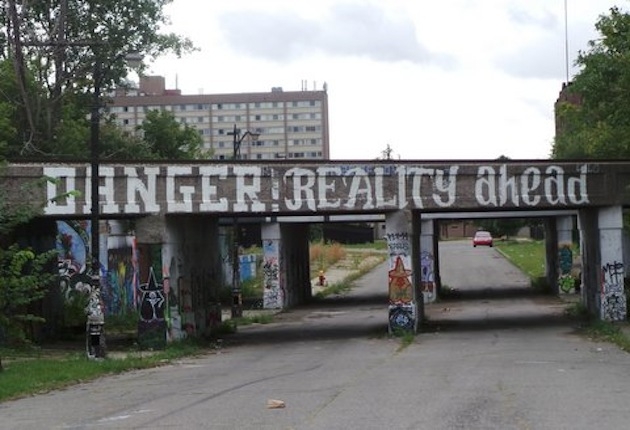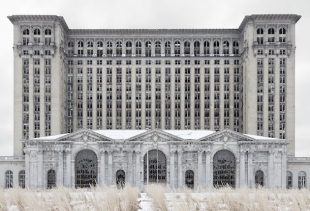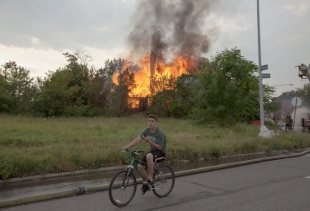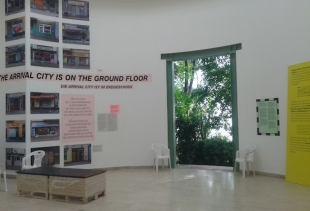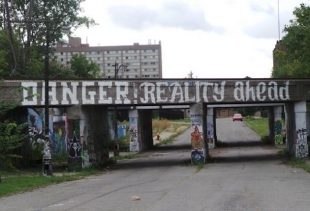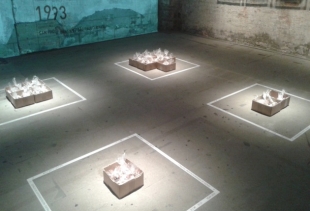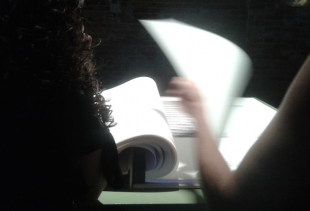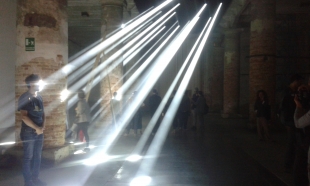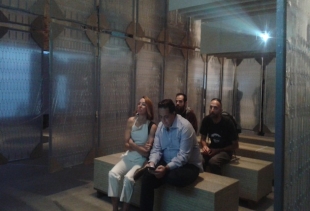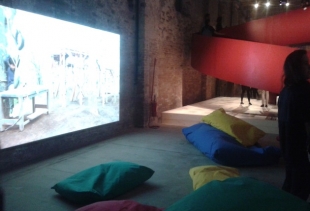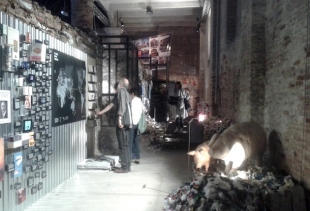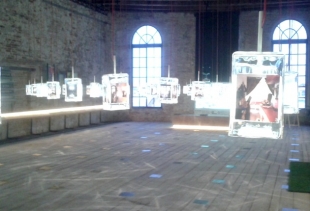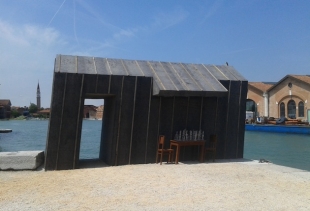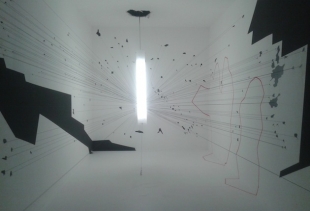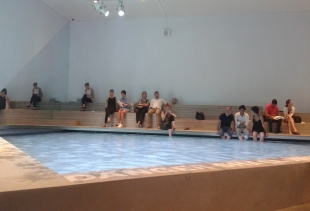» archive blog
-
Carnal, issue 0 of Parterre de Rois
A new magazine in Milandate: 18-07-2013
-
Interview with Nicola Toffolini
A worlds inventordate: 24-04-2011
-
Donne senza uomini.
Installazione multimediale di Shirin Neshatdate: 01-03-2011
A Biennale on the sly? Six months at Reporting from the Front
Shows, conferences and for the first time also applied arts. Less events, more partners
It is since a while we tell you about the peculiarities of this Architecture Biennial on the sly that will take place in Venice, in its fifteenth edition, on May 28-November 27 2016.
We maybe did it in the best way by starting from its director Alejandro Aravena and a long and gritty interview in which he told us where the curatorial statements goes (and what it does not mean). We also told you of very different other participants, commissioners and curators.
We have also let you meet in our pages Leila el-Wakil, professor and architecture historian who signs a particularly sparkling edition of Salon Suisse (collateral event of Swiss culture in Venice, organized in form of debates and meetings in a nice ballroom of a Dorsoduro Palazzo that hosts also the Swiss Consulate in town). This year for those will not come in Venice there is an online streaming curated by a Swiss architecture magazine.
To open the 'ballroom' on May 27 is the vernacular architecture but it is maybe convenient to download the entire program that will follow all the months of Biennale duration (online and offline) for a weekend per month.
Now we like to tell you, more in details, what do not loose and what to go in depth before to plan your visit. We start from the national participations (less than the last year, 64, with 5 ones for the first time on show: Philippines, Nigeria, Seychelles and Yemen, this last to get a glance on considering the state of war in the country). And from the ones at Giardini.
Maybe we hazard a prevision of award, quite impossible given the rules of the Lions (but who knows…anyway the jurors this year are: Pippo Ciorra, Sergio Fajardo, Marisa Moreira Salles, Hashim Sarkis, Karen Stein). We might say: ex-aequo USA/Germany given the curatorial idea and the pavilion design – even if the German set design will be uneasily surpassed…
US curators Cynthia Davidson and Mónica Ponce de León – we will interview both on their first day of show – called very different American architecture practices to rethink Detroit (the show titles is very programmatic: The Architectural Imagination ).
The motor city is so read (and reimagined) twelve times by: A(n) Office, BairBalliet, Greg Lynn FORM, Mack Scogin Merrill Elam Architects, Marshall Brown Projects, MOS, Pita & Bloom, Present Future, Preston Scott Cohen Inc., SAA/Stan Allen Architect, T+E+A+M, Zago Architecture who will host also debates in the pavilion during the following months.
Reporting from the Front has its best incarnation in Making Heimat the German Pavilion proposal, developed by the Deutsches Architekturmuseum (DAM) based in Frankfurt and managed by Peter Cachola Schmal. They rethought totally the architecture of the pavilion – and this will surprise you especially if you maybe remember last edition was hosting a representation of a famous government cottage. This time it will be empty and open, its windows and doors demolished and the holes enlarged. Only some bricks organized as benches will be present (together with few poster stick on the walls). The bricks hide the sockets to recharge portable devices. So, the German Pavilion will be always open - wounded, night and day – and it will be a perfect shelter for homeless and not.
With no fences and no defence, it will be not at all empty…beside the posters and the bricks, it hosts a database, that is already online and working. It stores housing projects for refugees and migrants the various authorities built in the country since 2010 and can be browsed via different criteria, as the budget, the year and/or the state of completion, the location, the mission. Instead of giving 3 billions to Turkey (including also the design of new housing there to stop the massive migrations in Europe and beyond) there is somebody who already did (since 2010) and found also the time and the professionals to share it with the whole mankind via an architecture show.
Conferences and talks; research, book and publications presentations are popping up with no pause especially in the opening days: we suggest you to do not miss the Archis one Whose Side Are You On? at the Dutch Pavilion together with a breakfast on May 27 from 10 am – the role of architecture in the peacekeeping missions of UN. The breakfast and the debate are useful to the presentation of Volume #48: The Research Turn that also embeds the catalogue of the show BLUE: Architecture of UN Peacekeeping Missions.
Of course also the Biennial itself organizes this year, after the Koolhas’ rebranding, the Meeting on Architecture, of which Rolex is so proud to sponsor also for this edition. A week-end each month (except July) the Meetings recalls the ‘Battles Words’ Aravena summarized in a drawing that is in the slide show of this post.
Beside the Meetings, useful to list are other special projects, two in particular: one curated by London School of Economics and Political Science and Ricky Burdett, the other the Progetto Speciale di Forte Marghera. The first is an international seminar of the series Urban Age entitled Shaping Cities: Conflicts Of An Urban Age, on July 14 and 15 from 10.30 at Teatro alle Tese Arsenale. It is not yet totally clear what will happen at Forte Marghera at the time we write. It is a show with which the Fondazione La Biennale starts to reshape a new area in the fortress.
There is also another conference, whose program is already stated and is really interesting, Sustainable Design Event, organized by LafargeHolcim Foundation for Sustainable Construction: it will happen on November 25th at Teatro Piccolo Arsenale at 5pm.
The international section curated by Aravena has 88 invited studios from around 20 different countries, 50 of them present for the first time in a Venice Biennale and 33 under 40.
Apart the traditional Biennale Sessions (more than 80 universities subscribed tailored programs of few days for their professors and students) there is this year the Summer School in the framework of Biennale College (in partnership with Victoria and Albert Museum and the Applied Arts Wien university, from July 9-17, Euro 1600 up to 35 participants). And the Arsenal hosts the most interesting exhibition of this Biennale, a survey on applied arts signed by V&A.
There is just the time to come back to the 19 collateral events (this year the quality is less impressive beside the quantity). According to us, another Swiss proposal is very interesting and comes from the Polytechnic of Lausanne that is about the horizontal metropolis. Which better spot for the exhibit and for the few conferences in the program that Isola della Certosa?
There are few exhibitions in town of which some we already shortlisted for you.
We here suggest you two different others that are very divergent also one from the other and of course are not in the official roster of the Biennial. One is a painting show, indeed very original – à la façon de Schifano and almost the counter melody of Rotella. The author is a young artist, Stefania Fersini from Turin (also member of a collective of designers, Nucleo). It is entitled Show on Show, hosted in a very shabby-chic palazzo close to Santa Maria del Giglio. Organized, again, by POOL NYC, a very sparkling gallery managed by Viola Romoli we introduced in an amusing interview few months ago.
The other is in a small art and collectible design gallery, Marignana (very close to la Salute church and to Fondazione Vedova, in the museum mile stretch of Dorsoduro). Until September 10, Marcello Morandini – Italian architect, artist, designer – shows images, three-dimensional objects and tableware (unique pieces).
Last but not least, and totally out from the official events of the Biennial but breaking the mould as usual, Fondazione Prada at Ca’ Corner della Regina opens on May 26 the research and show Belligerent Eyes. Until September 11 (and particularly issued for the Venice Film Festival) it is a platform rather than only a show regarding the production of contemporary images – cinema and visual culture are since the inception of the foundation the preferred languages of Miuccia Prada. This and many other precedent exhibitions on the same topic have been not curated by Germano Celant.
Stay tuned with us: we will review, interview and collect images and impressions by all the exhibits by publishing on our socials and on this website. If you like to receive exclusive features or preview features before anybody else, subscribe our free newsletter sending us a request email!
---
Review, May 28, 2016
A long walkway, back and forward: our impressions are largely positive (but we did not guess the awarded pavilion, the ones we selected are still the best one!)
Visitors will get a totally new experience once visiting the 15th Venice Architecture Biennale, they will find it totally different from any similar architecture festival and of course very different also from the previous editions. It is a total countertrend.
Visitors who are architects – as Aravena said – will be helped toward their ‘blank pages’, their creativity gaps. Aravena did not privilege only Latino American or tier monde approachs and also accepted proposals from practices he did not invited directly. This Biennial will help with ideas, proposals and evaluation that maybe some architects did not have before and so will help to think more or better to very important ‘preposition’ when about to design: context, history, materials, durability from the social and collective perspective.
If visitors will be curious people or travel-fans – more in general audience that is not linked to design professions but are loving to listen to different opinions – they will be in the right place to enjoy. This Biennial will serve well to enlarge many horizons, such as which countries to visit or to come back (and why), to meet unexpected communities and territories.
If the visitors will be the decision makers, they should come back with all the colleagues of their offices who did not visit the festival or maybe they should organize a day with them to show pictures and projects to adopt (if they will be enought brave and honest).
At the Arsenal – and at the Giardini, as well - the International show starts with a bold statement that recalls the collective rotor design (the Belgian architects are strangely absent from this Biennale). A great oval is built by using the drywalls and other debris of the previous Biennial – more than 10.000 cubic meters of scrap made by Enzewor – and makes home to small video-screens that tell about conversations, emails and sketches. It is the ‘making of’ of Aravena’s Biennial since his appointment as director. He starts to tell what he designed and which kind of Biennial he had in mind to present. And then you see it: immediately.
Organized in macro-themes that, one in another, permeate very naturally, it tells the challenges of contemporary architecture at any latitude and surely among them the main ‘battle’ is the one of the migrations (caused by wars, or drought, famine or poverty in general: internal, transnational, temporary). They master either big scale projects and more viable ones. Social inclusion is an equally important ‘battle’ with the keener use of materials and the better place to assign to the work for (and with) a community – the first and truest clients of this responsible (and sustainable) architecture.
By starting with the work for (and with) the communities, two are the projects to do not miss (that also represent a different way to design a travel). One is by Assemble (UK) that shows a small cinema with the work done for resistant communities, for instance the residents of the beautiful and damned (for the speculation) Liverpool district of Toxteth.
Even more compelling is a work enclosed in a very special cinema, it is how a practice from US (Rural Studio) works since 25 years always in the same territory and for the same communities where it has been founded (Alabama). It is the States of the middle, poor, areas. Their cinema hall is build with bed bases, wooden boards and small cabinets. Its video design is amazing, the best seen in the show and provided with a timeline and a kind of graphic egg timer that helps the more rushed visitors to know how much time lacks from the next video.
The movie hall will become a donation for casette a social housing project founded by a resident movement that takes the empty spaces (houses, offices, old workshops), by restoring them and giving to homeless. Rural Studio got the idea of the cinema to show their works by the movement of casette and they so made a video on them and dedicated the mean and the money for the show to them, who work also together with Centro Sociale Rivolta and Cooperativa Garagol for refugees.
Crepuscular light and the act of trespassing – more specifically the value to give to landscape: beauty has to be usable by everyone in the same democratic and equal way! – are very present in this biennial. Regarding the first, a superb installation (obtained by halogen light Sharpy that perforate an obscured ceiling in the Arsenale) is Transsolar, technology serving common sense and poetry!
Hugon Kovalski on the contrary speaks of garbage, not only about the illegal dumps but also about the millionaire business that derives from (often illegal or ‘informal’): be prepared once entering in his container, to a very unexpected trip. The Alexander Brodsky poetics is embedded in the lagoon natural landscape, the Gaggiandre one precisely, and invites visitors to play chess with time, necessity, perspective and scarcity in architecture. His installation is a mute shack with a chess game. You will discover more about it once very close, we do not want to reveal what.
Travelling with this Biennial is possible in many ways. Inside it and thanks to it in real places. It is first of all possible to travel with poetry, with music and with literature. It is what happens in two pavilions thanks to very different approaches. One is the Albanian (Arsenale), the other is Belgium (Giardini). In the first, the ‘object’ on show is a record in vinyl with an attached booklet of tales, poems, writings, in form of songs (to listen to, a bit kidnapped, on evanescent and super light stools designed and made by Max Lamb with resin and polystyrene). It celebrated the material heritage to be protected by Unesco (popular songs). In the second a ‘concept’ is on show: the bravoure and the old knowledge to use within the scarcity. It is declined with texts, pictures, videos and bids of furniture (especially Kruk, a very intelligent stool designed by doorzon interieurarchitecten by starting with a pipeline and with sponge. Six of them are looking for an owner).
It is the Austrian Pavilion (Place for People, Giardini) to drive more attention on temporary design for communities made of displaced or migrants. From islands of curtains where to place beds giving a small amount of privacy within repurposed architectures, to ‘camp’ design with an open source book to design minimal furniture and tableware with a mission of being very communicative to aggregate migrants.
Again on the ‘topic’ place as place for a common growth, Australia dedicates the exhibit to a specific architecture – the pool (it is the country with the highest pro-capita rate of swimming pools, 1.2 millions, and the highest rate of new ones per year, 30.000). For them the pool is the place of the community per excellence (and it has been a place for many battles of the residents when some of them have been demolished to leave space to other architectures). The pool also represents the delicate relation Australians have with their colonial history, and with the water scarcity. The show is composed by a very low water (and real) swimming pool that is very suitable for children (during the opening days it has been always full!) that takes almost all the space of the big pavilion. There are chairs designed by an Australian and manufactured by an Aboriginal design company. And there is an audio installation, that takes back the texts of a very keen publication to read and to keep. The book (The Pool, ISBN 9 780646 949659) collects also stunning pictures of artesian billabong, rocky pools or artworks on the theme of the water.
For movies or biopic lovers (also in world premiere) on design and architectures, the Garden of Tese alle Vergini is the embedded cinema in this biennial. It is part of the Aravena’s International section but is also a public domain given the garden is open, daily from 10 to 6, for free: it is a recent conquer of the citizens of Sestiere Castello who fought in order that marvelous corner of green annexed by the Biennial can become again public space as it was. There is no need for a ticket to see in those hours the Amos Gitai’s movie on Herzog&DeMeuron, to see Workplace and all the other video works in the garden designed, among the others, also by landscape designer Piet Oulolf, where to find also edible bushes of white and red nettle. And also where to find WarkaWater, a structure in a shape of a tower designed by Italian architecture practice Architecture&Vision that creates (drinkable) water obtained from the fog, the rain water and, especially, the condensation of the atmosphere.
The fact this edition of the festival is different, has been evident also from the unexpected appearance, just few hours before the opening, of a shelter built by scrap for the homeless living usually on the edge of the door of Teatro Piccolo (Arsenale). It is on wheels, it is a small house with a blind side watching the street and opened from the opposite one. On a wall of the ‘house’ (made with pvc and other materials of the previous instalments) there was a message in an uncertain Italian - ‘una casa per te’ (house for you). The shame is that apparently the homeless is Dutch and that, normally, he does not speak at all. I crossed his glance one night by coming back home and for the first time he replied with a smile to mine when I was pointing his new mansion.

